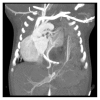Coexistent Congenital Diaphragmatic Hernia with Extrapulmonary Sequestration
- PMID: 27445516
- PMCID: PMC4904537
- DOI: 10.1155/2016/1460480
Coexistent Congenital Diaphragmatic Hernia with Extrapulmonary Sequestration
Abstract
Bronchopulmonary foregut malformations are a heterogeneous but interrelated group of abnormalities that may contain more than one histologic feature. It is helpful to be familiar with the presentation and imaging features of bronchopulmonary foregut malformations presenting as a congenital mass or mass-like lesion, as imaging plays a central role in the evaluation of these lesions since, when symptomatic, clinical features are usually nonspecific. With imaging, the presence of other associated lesions can be determined, facilitating appropriate management to prevent the potential complications. We report a case of coexisting extralobar pulmonary sequestration and ipsilateral diaphragmatic hernia in a term neonate.
Figures




References
Publication types
MeSH terms
LinkOut - more resources
Full Text Sources
Other Literature Sources

